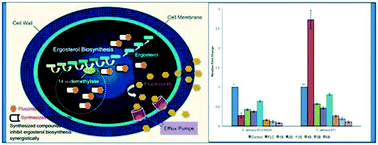当前位置:
X-MOL 学术
›
RSC Med. Chem.
›
论文详情
Our official English website, www.x-mol.net, welcomes your
feedback! (Note: you will need to create a separate account there.)
Synergistic antifungal effect of cyclized chalcone derivatives and fluconazole against Candida albicans
RSC Medicinal Chemistry ( IF 4.1 ) Pub Date : 2017-10-17 00:00:00 , DOI: 10.1039/c7md00440k Aijaz Ahmad 1, 2 , Mohmmad Younus Wani 3, 4, 5 , Mrudula Patel 6 , Abilio J F N Sobral 4 , Adriano G Duse 1, 2 , Faisal Mohammed Aqlan 5 , Abdullah Saad Al-Bogami 5
RSC Medicinal Chemistry ( IF 4.1 ) Pub Date : 2017-10-17 00:00:00 , DOI: 10.1039/c7md00440k Aijaz Ahmad 1, 2 , Mohmmad Younus Wani 3, 4, 5 , Mrudula Patel 6 , Abilio J F N Sobral 4 , Adriano G Duse 1, 2 , Faisal Mohammed Aqlan 5 , Abdullah Saad Al-Bogami 5
Affiliation

|
The occurrence of invasive fungal diseases, particularly in immunocompromised patients, is life-threatening and increases the economic burden. The rising problem of multi-drug resistance is becoming a major concern for clinicians. In addition, a repertoire of antifungal agents is far less in number than antibacterial drugs. To combat these problems, combination therapy has gained a lot of interest. We previously reported the synergistic interaction of some mono- and bis-dihydropyrimidinone and thione derivatives with fluconazole and amphotericin B for combination antifungal therapy. In this study we used the same approach and synthesized different azole and non-azole derivatives of mono-(M) and bis-(B) chalcones and evaluated their antifungal activity profile alone and in combination with the most commonly used antifungal drug – fluconazole (FLC) – against seven FLC susceptible and three FLC resistant clinically isolated Candida albicans strains. Based on the minimum inhibitory concentration results, the bis-derivatives showed lower MIC values compared to their mono-analogues. Both fractional inhibitory concentration index and isobologram results revealed mostly synergistic, additive or indifferent interactions between the tested compounds and FLC against different Candida isolates. None of the tested compounds showed any effect on energy dependent R6G efflux, revealing that they do not reverse the mechanism of drug efflux. However, surprisingly, these compounds profoundly decreased ergosterol biosynthesis and showed down regulation of ERG11 gene expression, which is the possible mechanism of reversal of azole drug resistance by these compounds. These results provide a platform for further research to develop pyrimidinone/thione ring containing compounds as promising new antifungal agents, which could be used in antifungal combination therapy.
中文翻译:

环化查耳酮衍生物与氟康唑对白色念珠菌的协同抗真菌作用
侵袭性真菌病的发生,特别是在免疫功能低下的患者中,会危及生命并增加经济负担。日益严重的多重耐药问题正成为临床医生关注的主要问题。此外,抗真菌药物的种类远少于抗菌药物。为了解决这些问题,联合疗法引起了人们的广泛关注。我们之前报道了一些单和双二氢嘧啶酮和硫酮衍生物与氟康唑和两性霉素 B 联合抗真菌治疗的协同相互作用。在这项研究中,我们使用相同的方法合成了单( M )和双( B )查尔酮的不同唑类和非唑类衍生物,并评估了它们单独以及与最常用的抗真菌药物氟康唑联合使用的抗真菌活性。 FLC) – 针对临床分离的七种 FLC 敏感菌株和三种 FLC 耐药菌株。根据最小抑制浓度结果,与单类似物相比,双衍生物显示出较低的 MIC 值。分数抑制浓度指数和等效线图结果都显示,测试化合物和 FLC 对不同念珠菌分离株之间主要存在协同、相加或无关的相互作用。所测试的化合物均未显示出对能量依赖性 R6G 流出的任何影响,表明它们不会逆转药物流出的机制。然而,令人惊讶的是,这些化合物显着降低了麦角甾醇的生物合成,并下调了ERG11基因表达,这是这些化合物逆转唑类药物耐药性的可能机制。 这些结果为进一步研究开发含嘧啶酮/硫酮环的化合物作为有前景的新型抗真菌剂提供了平台,可用于抗真菌联合治疗。
更新日期:2017-10-17
中文翻译:

环化查耳酮衍生物与氟康唑对白色念珠菌的协同抗真菌作用
侵袭性真菌病的发生,特别是在免疫功能低下的患者中,会危及生命并增加经济负担。日益严重的多重耐药问题正成为临床医生关注的主要问题。此外,抗真菌药物的种类远少于抗菌药物。为了解决这些问题,联合疗法引起了人们的广泛关注。我们之前报道了一些单和双二氢嘧啶酮和硫酮衍生物与氟康唑和两性霉素 B 联合抗真菌治疗的协同相互作用。在这项研究中,我们使用相同的方法合成了单( M )和双( B )查尔酮的不同唑类和非唑类衍生物,并评估了它们单独以及与最常用的抗真菌药物氟康唑联合使用的抗真菌活性。 FLC) – 针对临床分离的七种 FLC 敏感菌株和三种 FLC 耐药菌株。根据最小抑制浓度结果,与单类似物相比,双衍生物显示出较低的 MIC 值。分数抑制浓度指数和等效线图结果都显示,测试化合物和 FLC 对不同念珠菌分离株之间主要存在协同、相加或无关的相互作用。所测试的化合物均未显示出对能量依赖性 R6G 流出的任何影响,表明它们不会逆转药物流出的机制。然而,令人惊讶的是,这些化合物显着降低了麦角甾醇的生物合成,并下调了ERG11基因表达,这是这些化合物逆转唑类药物耐药性的可能机制。 这些结果为进一步研究开发含嘧啶酮/硫酮环的化合物作为有前景的新型抗真菌剂提供了平台,可用于抗真菌联合治疗。











































 京公网安备 11010802027423号
京公网安备 11010802027423号